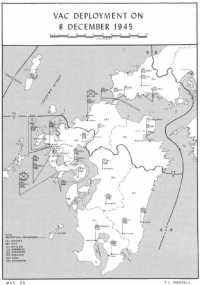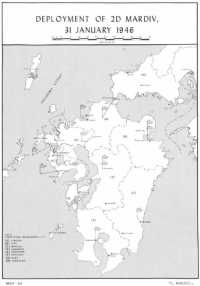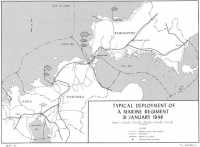Chapter 3: Last Months in Japan
Americans, uncertain of how the Japanese people would accept the occupation, had their doubts allayed within a short time after the troops had landed and begun fulfilling their missions. Original Japanese qualms about associating with their conquerors were quickly dispelled after the children:
... were the first to lose their fear. These doll-like small fry, most of them wearing uniforms and thoroughly accustomed to saluting, soon began to line the streets and gaze with wide eyes at the Marines and their vehicles. The children’s curiosity was soon shared by their elders. Old and young alike seemed especially amazed at the American jeeps and trucks which, regardless of heavy rains and bad roads had the power to travel where their drivers took them. Bulldozers and other earthmoving equipment brought even more amazement. And not the least of the startling sights were the Marines themselves. Men with blue eyes and light hair were astonishing enough, but red-haired Marines were beyond imagination.1
Japanese cordiality and hospitality became evident as the Marine occupation forces spread out over the island of Kyushu. Other signs of the presence of American troops were the English language safeguard markers placed on churches, religious shrines, and schools, warning occupation troops away and exempting these places from search and trespass.
Although fraternization with the Japanese was not permitted at first, these restrictions were soon eased and it did not take too long for the Marines to learn more than they had known previously of the Japanese way of life and to appreciate Japanese customs and culture. At the same time, the Japanese were often awestruck by the manner and means by which the Americans could accomplish tasks which the Japanese considered difficult but which the Marines considered normal routine. Japanese standards of living and efficiency were woefully below those of the Western world, and the former enemy nation sadly lacked transportation and construction equipment and tools. Most Japanese primary and secondary industry had been devastated in the air raids. Besides, Japanese industrial facilities had long been geared to the production of war materiel rather than consumer goods, or housing, or any of the other products that the civilian population of the Allies was able to obtain, even in wartime.
Japanese men and women alike labored days to accomplish what the Americans with their heavy equipment and know-how could do in minutes. The backward conditions of the Japanese could be blamed partially on the war, but even more so on a way of life and a social structure that had remained largely unchanged for centuries. Although the opening of Japan by the West
in the mid-19th Century caused a severe jolt to Japanese attitudes and sensibilities, it was nothing compared to the changes wrought by the American occupation.
There had indeed been many changes and much accomplished by the end of the first few months of occupation, during which time the occupation forces enforced the surrender terms. The Japanese armed forces had been almost completely demobilized, 90 percent of the military facilities in the Home Islands had been razed, and approximately 20 percent of the ammunition and explosives stored in bunkers all over Japan had been destroyed. Eighty percent of the war matériel and equipment still in usable condition had been turned over to the Japanese Home Ministry for conversion to peacetime use.
In the 5th Division area, the 13th Marines alone had supervised the scuttling at sea or the destruction by other means of 188,000 rounds of artillery and mortar ammunition, 25,000 aerial bombs, 1,800 machine guns, 270 torpedoes, 4,500 mines and depth charges, 83 large guns, 400 tons of aircraft parts, 30 tons of signal equipment, 650 tons of torpedo parts, and 161 miscellaneous types of machines that were geared for the manufacture of war materiel. Other VAC units completed similar demolition missions. Even while they enjoyed their stay in Japan and carried out their occupation duties, “‘Home, when do we go there.’” was the single most important topic of conversation among the Marines in Kyushu.2
Marine Withdrawal3
By 30 November, only about 10 percent of the Marines in VAC had been returned to the States, although discharge and rotation directives had made more than 15,000 men eligible. Marine divisions were under orders to maintain their strength at 90 percent of T/O, and these restrictions severely curtailed the number of men that could be released. Replacements were almost nonexistent in this period of postwar reduction. Still, the 2nd Division, which was to remain in Japan, had 7,653 officers and men who were entitled to return home.4 To meet this problem, VAC ordered an interchange of personnel between the 2nd and 5th Marine Divisions.
High-point men of the 2nd Division would be transferred to the 5th Division, and men not yet eligible for discharge or rotation would move from the 5th to the 2nd in exchange. Almost half of the 2nd Division and 80 percent of the 5th Division, in all about 18,000 Marines and corpsmen, were slated for transfer. At the same time that the personnel exchanges took place, elements of the 2nd and 32nd Divisions occupied the 5th Division zone of responsibility so that the occupation mission of surveillance, disposition
of matériel, and repatriation could continue without interruption.
On 24 November, control of Saga and Fukuoka Prefectures passed to the 2nd and 32nd Divisions respectively. (See Map 29.) In the first of a series of comparable troop movements, 2/6 entrained for Saga to take over the duties and absorb the low-point men of 2/27. The 6th and the 10th Marines occupied the 5th Division zone, relieved units of the 13th, 27th, and 28th Marines, and effected the necessary personnel transfers. The 2nd and 8th Marines sent their returnees to Sasebo, the 5th Division port of embarkation, and joined new men from the infantry regiments of the 5th. Separate battalions and headquarters troops of both divisions exchanged men with their opposite numbers.
The 5th Division began loading out as soon as ships were available at Sasebo, and the first transports, carrying men of the 27th Marines, left for the States on 5 December. The 2nd Division assumed all of the remaining occupation duties of the 5th on 8 December, and the last elements of the 5th Division departed Sasebo 11 days later.
Beginning on 20 December, with the arrival Stateside of the first troopships of the 27th Marines, a steady stream of officers and enlisted men passed through reassignment and discharge centers at Camp Pendleton. During January, most of the organic elements of the division were skeletonized and then disbanded. On 5 February 1946, the Headquarters Battalion followed suit “and the 5th Marine Division passed into history.”5
On the same date that the 2nd Marine Division took over the duties of the 5th, VAC received a dispatch directive from the Sixth Army stating that the corps would be relieved of occupation responsibilities on 31 December, when the Eighth Army was to assume command of all Allied occupation troops in Japan, and plans were laid to reduce American strength to the point where only those units considered a part of the peacetime Armed Forces would remain. I Corps, with headquarters at Osaka (later Kyoto), would take over the area and troops of VAC.
The VAC spent most of its remaining time in Japan completing its current occupation missions, supervising the transfer of low-point men to the units of the 2nd Division, and preparing to turn over the area to I Corps. As had been ordered, the changeover took place on 31 December 1945, and VAC troops began loading out the following day, some units for return to the United States and others for duty with Marine supply activities on Guam. On 8 January, the last elements of VAC, including General Schmidt’s headquarters, left Sasebo for San Diego where on 15 February 1946, it was disbanded.6
Not long after the departure of VAC from Japan, the 2nd Marine Division became responsible for the whole of what had been the corps zone. The 32nd Infantry Division, a former Michigan-
Map 29: VAC Deployment on 8 December 1945
Wisconsin National Guard outfit, was one of the Army units slated for deactivation early in 1946. In preparation for taking over the duties of the 32nd Division in Yamaguchi, Fukuoka, and Oita Prefectures, the 2nd Division began moving units of the 6th Marines north to the Army zone and increasing the size of the areas assigned to the other regiments. On 31 January, when the 2nd Division formally relieved the 32nd, the prefectural responsibilities of the major Marine units were: 2nd Marines, Oita and Miyazaki; 6th Marines, Yamaguchi, Fukuoka, and Saga; 8th Marines, Kumamoto and Kagoshima; 10th Marines, Nagasaki. (See Map 30.)
At this time, the 2nd Division command post was in Sasebo, and the CPS of the regiments were located as follows: 2nd Marines, Miyazaki; 6th Marines, Fukuoka; 8th Marines, Kumamoto; and the 10th Marines, Nagasaki. An increase in the size and number of areas assigned to the 2nd Division meant that Marine occupation responsibilities were similarly enlarged. The routine of guard, patrol, repatriation, and disposition duties grew apace with the areas in which they were accomplished.
A typical regimental disposition in this phase of the Marine occupation may be seen in the deployment of the 6th Marines on 31 January. (See Map 31.) The regimental headquarters and 1/6 CP were at Fukuoka; the CP of 2/6 was at Saga. The battalion headquarters company and Companies K and L of 3/6 were located at Kokura; Company I was at Senzaki in Yamaguchi Ken. From these widely separated localities, units of the 6th Marines maintained a daily occupation routine that remained largely the same until the entire division departed Japan.
When Major General Roscoe B. Woodruff, commander of I Corps, returned to the United States on temporary assignment on 8 February, Major General LeRoy P. Hunt, Jr., the commander of the 2nd Marine Division and senior division commander in the corps, flew to Kyoto and assumed command of the corps, a position he retained until General Woodruff’s return on 5 April. The corps zone of responsibility underwent one more change during this period. Advance elements of the British Commonwealth Occupation Force (BCOF) began moving into Hiroshima Prefecture on 4 February and formally took control from the 24th Infantry Division on 7 March. On the 23rd, the BCOF formally relieved the 6th Marines in Yamaguchi Prefecture, reducing the 2nd Marine Division zone to the island of Kyushu.
By April, it seemed that the constant shifting of units was largely over and that the divisions of I Corps could concentrate mainly on reinstituting regular training schedules. The 2nd Marine Division had been pared down to peacetime strength by 11 February, when the third battalion of each infantry regiment and the last lettered battery of each artillery battalion were relieved of occupation duties, assembled at Sasebo, and then sent home for disbandment. Insofar as possible, the remaining units were assembled in battalion-sized camp areas, which served as centers from which surveillance of the local zone of responsibility was maintained. When not undertaking occupation missions, the Marines attended
Map 30: Deployment of 2nd MarDiv, 31 January 1946
classes in basic military subjects, fired individual and crew-served infantry weapons, and carried out field exercises in combat tactics. An efficient air courier service of liaison planes and occasionally transports, operating out of the Marine air base at Omura, connected the scattered battalions and enabled the division and regimental commanders to maintain effective control of their units. The Marines had disposed of most of the Japanese war materiel and the tremendous repatriation flow of the first months of the occupation had slowed. The Japanese, as well as their conquerors, had settled into a routine of mutual tolerance, and often a relation much closer and stronger than that.
Soon after General Hunt had returned from Kyoto, he received word from Eighth Army that the 2nd Division would be returned to a permanent base in the United States. The 24th Infantry Division would move to Kyushu and take over the Marine zone. Preparations for the movement got underway before the end of April, when reconnaissance parties of the relieving Army regiments arrived to check their future billeting areas.
General Hunt planned to relieve his outlying units first and then gradually to draw in his men upon Sasebo until the last unit had shipped out from the port. Oita and Miyazaki were the first prefectures to be handed over to the Army, and their former garrison, the 2nd Marines—whose CP had been moved from Miyazaki to Oita on 18 March—was the first unit to complete loading out. The regiment left Sasebo on 13 June bound for Norfolk, and the 8th Marines followed soon after. General Hunt turned over his zone to the 24th Division on 15 June, and Marine responsibility for the occupation of Kyushu ended.7 Division headquarters left on 24 June and with the exception of service troops and rear unit echelons, which remained to load out heavy equipment, the major elements of the 2nd Marine Division all had departed by 2 July.8 General Woodruff attested to the accomplishments of the 2nd Marine Division in the following farewell message to General Hunt:–
Today the 2nd Marine Division comes to the end of its long trail from Guadalcanal to Japan. Its achievement in battle and in occupation: ‘Well Done.’ The cooperation and assistance of your splendid Division will be greatly missed. I Corps wishes you bon voyage and continued success in your next assignment. Woodruff.9
As a result of the acceptance of defeat by the Japanese, it was never necessary to institute complete military rule. General MacArthur’s directives outlining a program of demilitarization and democratization were put into effect by a Japanese Government that disarmed and demobilized its own military forces and revamped its political structure without serious incident.
Map 31: Typical Deployment of a Marine Regiment, 31 January 1946
As MacArthur recalled in his memoirs:
From the moment of my appointment as supreme commander, I had formulated the policies I intended to follow, implementing them through the Emperor and the machinery of the imperial government ... the reforms I contemplated were those which would bring Japan abreast of modern progressive thought and action, First destroy the military power. Punish war criminals. Build the structure of representative government. Modernize the constitution. Hold free elections. Enfranchise the women. Release the political prisoners. Liberate the farmers. Establish a free labor movement. Encourage a free economy. Abolish police oppression. Develop a free and responsible press. Liberalize education. Decentralize the political power. Separate church from state.
These tasks were to occupy me for the next five years and more. All were eventually accomplished, some easily, some with difficulty ... I cautioned our troops from the start that by their conduct our own country would be judged in world opinion ... Their general conduct was beyond criticism ... They were truly ambassadors of good will.10
The Marines in Kyushu stood by as observers and policemen during many phases of the occupation operation, but were directly concerned with others. They supervised the repatriation of thousands of foreign civilians and prisoners of war and handled the flood of Japanese returning from the defunct overseas empire. Using local labor, the Marines collected, inventoried, and disposed of the vast stockpile of munitions and other military materiel that the Japanese had accumulated on Kyushu in anticipation of Allied invasion. Where necessary, they used their own men and equipment to effect emergency repairs of war damage and to help reestablish the Japanese civilian economy.
Within three months after its landing on Kyushu, the V Amphibious Corps had established effective surveillance over the entire island and its ten million people and had set up smoothly functioning repatriation and disposition procedures. The task was so well along by the end of 1945 that responsibility for the whole island could be turned over to one division. Perhaps the most significant benefit to accrue to the Marine Corps in the Japanese occupation was the variegated experience gained by the small unit leaders in fields widely separated from their normal peacetime routine of training and guard duty. Facing heavy responsibilities, the Marines’ ability to adapt themselves to new situations and learn as they went along made the occupation of Kyushu a success.


